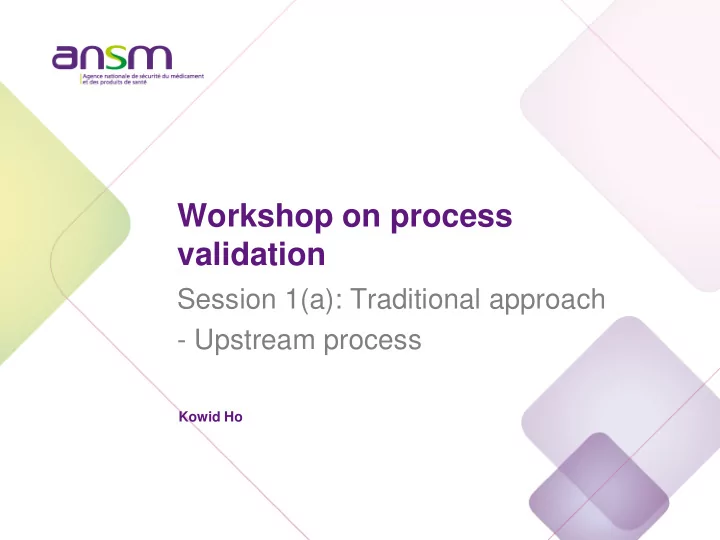

Workshop on process validation Session 1(a): Traditional approach - Upstream process Kowid Ho
Culture steps Evaluation of cell culture steps: From the introduction of the starting material in the manufacturing process (e.g. thaw of the WCB) up and beyond production level, Demonstration of capability of consistently delivering inoculates, harvest(s), and ultimately a drug substance of appropriate quality. Considering the complex matrices during cell culture and harvest steps, the evaluation/validation could, in part, rely on the analysis of drug substance and/or intermediates obtained at a later stage of the process. Include control of: specific cell traits or indices (e.g. morphological characteristics, growth characteristics (PDL), cell number, viability biochemical markers, immunological markers, productivity of the desired product, oxygen or glucose consumption rates, ammonia or lactate production rates), operating conditions (e.g. time, temperatures, agitation rates, working volumes, media feed, induction of production, end of culture). End fermentation / initiation of harvest(s): appropriately defined and evaluated. For multiple harvests: evidence that the quality of the product (e.g. yield, content, post translational modifications such as glycosylation, HCP, DNA) are consistent throughout the harvesting steps, or variability appropriately managed by pooling strategy. Agence nationale de sécurité du médicament et des produits de santé 1
Culture steps Verification of consistency of the process parameters/product quality attributes covering Includes all culture steps under defined manufacturing conditions Process parameters and Performance indicators in accordance to proven acceptable ranges Complete duration of the fermentation process (including entire process time for continuous fermentation) appropriate number of consecutive runs For multiple harvests: confirmation that it will not have an impact on the quality and consistency of drug substances batches Continued Verification could include: Stability (storage) of cell banks ? Stability of frozen intermediate ? Controls related to change in raw materials ? Control of batches derived from additional fermentation campaign (e.g. long fermentation run leading to several harvests and batches per run) ? Control of sub-cultures derived at different stages of seed trains each sub- culture ? Agence nationale de sécurité du médicament et des produits de santé 2
Culture steps Should genetic stability of the cell line be considered as a performance indicator to be part of the validation of the upstream process? Process parameters and quality attributes to be tested? Should qualification of biological raw materials and other raw materials be addressed in the guideline and documented in the dossier? What performance indicators should be considered for the validation of a continuous perfusion process? How to verify reliability/predictability of small-scale models for the upstream and downstream processes? Agence nationale de sécurité du médicament et des produits de santé 3
Equipment Information about key equipment (cell culture bottles, bags, fermeters) used, should be provided. This typically includes information on size and material. Disposable single use equipment. assess the suitability of the systems used. full scale equipment has to be used. various batches of disposable systems should be used in order to assess their impact on the product quality. When used for media preparation and/or harvesting: their potential impact on the yield and quality of the active material should be studied In case of single-use equipments or facilities, what are the main differences between process validation studies and studies to qualify these equipments and facilities? Agence nationale de sécurité du médicament et des produits de santé 4
Multifacility production Additions of alternative sites: frequently occurring. new site is rarely identical to the approved process (e.g. include adaptations and/or optimisations) Local adaptations: Normally accepted provided appropriate comparability data are shown. (e.g. different filters with same porosity) how far can this be stretched ? (e.g. different scale, conditions, raw materials, centrifugation vs filtration) Alternate process Cannot be ruled out that may give rise to slightly different purity/impurity profile risk of drift with future changes How to manage and validated differences between sites? Agence nationale de sécurité du médicament et des produits de santé 5
Recommend
More recommend